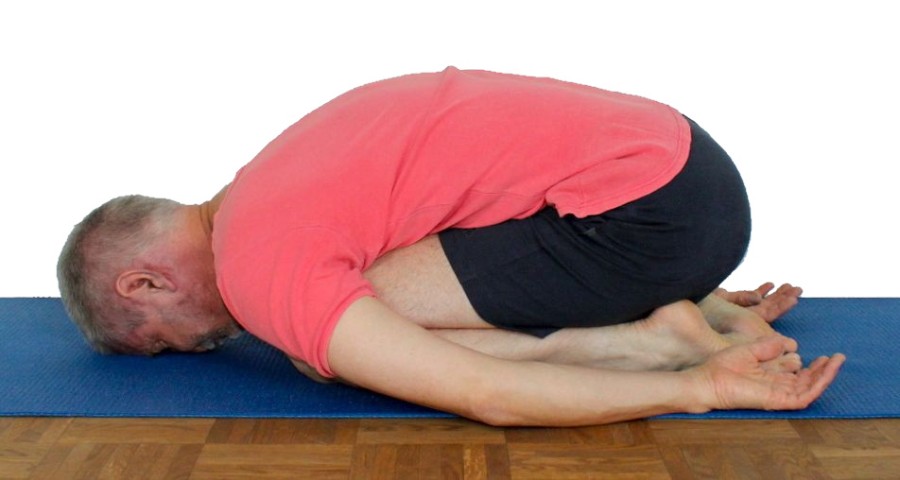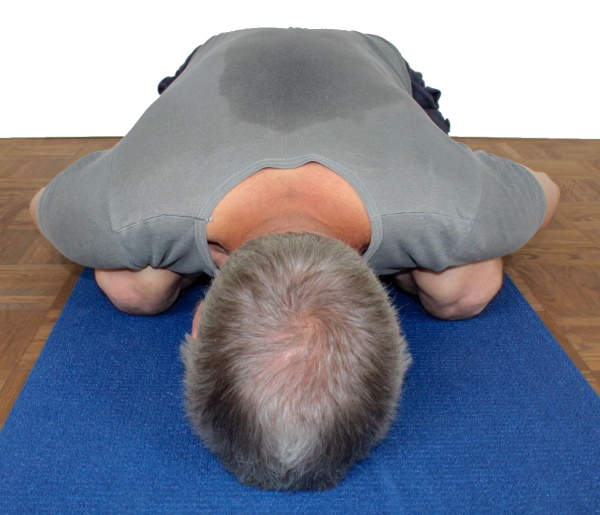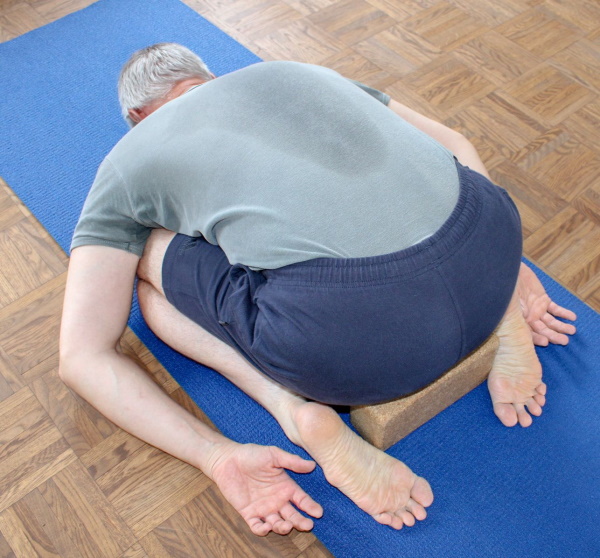- sit on the lower legs
- bend forward from the hips and place the upper body on the thighs
- if possible, put your head on the floor. If necessary, use a pad or other support to drop your head.
- put your arms comfortably backwards towards the pelvis, the palms of your hands point towards the ceiling
|
- the child's position is a pure, comfortable resting position and has no ambitions
with regard to stretching, strengthening, coordination or the like!
- At first glance, the child's position is somewhat similar to the virasana forward
bend. However, since the butts rest on the heels - if the thighs are
sufficiently flexible - it is of far less demanding nature to the health
of the knees and the flexibility of the thighs. Whereas in virasana the
butts sink to the ground, which presupposes good flexibility of the
monoarticular quadriceps parts, in the child's position an average
flexibility is sufficient to place the butts on the heels. In the forward bend,
the butts may want to lift off again a little, because the upper body
pushes the pelvis downwards less. If the butts hanging in the air is
perceived as unpleasant or stressful in the knees, the butts can be put
on a support which hopefully completely eliminates such problems.
This does not affect the child's position in any way. although support
it would be not desirable in virasana, since it is meant a stretching
of the monoarticular quadriceps parts that are significantly less affected,
for example in supta virasana.
- As an alternative to the position of the arms in the back, they can also be
stretched forward beside the head. Depending on the flexibility of the
quadriceps, i. e. the height of the pelvis, and the flexibility of the
butt muscles, i. e. the height of the upper body, this requires more or
less flexibility in the shoulder in the sense of frontal abduction.
Of course, the arms are laid down completely relaxed and do not have to stretch.
- If the head cannot be laid down on the floor or only with tension in the neck,
a support of the head should be used, unless the child's position would
be carried out just because of the slight stretching effect on the back!
- Similar to virasana, a tendency to cramp in the sole of the foot or a more or
less pronounced stretching sensation in the foot lifter muscles (lower leg front)
can also occur here. The former is always to be avoided, in the latter it can
be decided to what extent it is detrimental to the desired relaxation effect
of the pose. In all cases, these two effects can be alleviated or eliminated
by supporting the ankle area, for example in the form of a part of the mat,
which is rolled up tightly and with little compressibility.
- The arms are only exorotated so far that only minimal tension occurs in the rotators.
The forearms are pronated in opposite to savasana, so that although the trunc faces the
floor insetad of the ceiling the back of the hand again points to the floor.
Thus, both a relaxation pose with supination and one with pronation are available
and the rotation of the arms varies significantly.
- The knees are usually hip-wide, but can also be kept further apart,
which is usually felt to be even more relaxing because the flexion in the hips
is more effortless and also because breathing is less restricted. If the thighs
are opened sideways to such an extent that the upper body hangs almost completely
free between the legs, the pose is usually perceived as less relaxing and,
if necessary, the head must give unpleasantly much weight on the ground.
- Similar to the virasana and supta virasana, it is advisable to pull the calves
outwards when taking the pose.
- Rarely a tendency to cramp can occur in the rectus femoris or the ventral hip
area feels shortened after the pose. In such cases limit the flexion angle
in the hips or relieve the strain on the flexion by using a support under
the head or choose the "wide" variant supporting the whole upper body
accordingly high.
| known issues that may occur even when practicing correctly |
|
|




